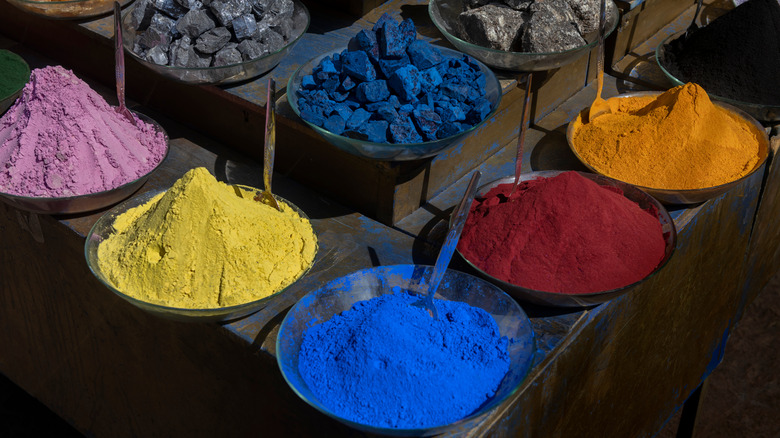Mulch is a boon to plants and gardeners alike, but dyed mulch can be a horse of a different color. Not all colored compost is the same, and not every variety is problematic. So is it safe? The answer is yes and no. Some dyed mulch is derived from questionable wood sources and has been linked to soil degradation, potential harm to flora and fauna, and possible toxicity to humans and pets. In addition, it can contain harmful binding agents or glue, and its chemicals might remain in the soil indefinitely, impacting plant growth. Per Doityourself, the most common mulch with dyes sold at hardware stores or garden centers is subpar lumber company products.
Edible plants might be affected by bad mulch, and in the extreme, fish, due to its chemical runoff. The situation has improved with the intervention of the Environmental Protection Agency (EPA) and the oversight of the trade association Mulch & Soil Council. Still, colorful compost products need to be purchased cautiously and used correctly to be safe for your garden.
Buying dyed mulch only from a reputable source is of paramount importance, and be sure to seek assurances the dye used is environmentally sound. Confirm that the product is composed of untreated wood or shredded bark and is not made from contaminated sources. Complete Landscaping Service recommends inspecting samples before purchasing. For conservation’s sake, a source that recycles and does not cut down trees for compost is best.
The wood is the problem, not necessarily the dye

Prior to 2003 and a ban enacted by the EPA, lumber treated with CCA — chromium, copper, and arsenic — was widely used to make mulch, NPIC notes. Construction and demolition waste was a prime source for mulching and composting ingredients, as was CCA-tainted wood salvaged from decks and fences. Other contaminants in recycled wood-turned-mulch included aluminum, lead from paint, and formaldehyde. Creosote-infused utility poles and railroad ties were also ground up to use in gardens. And while new wood products are currently prohibited from containing CCA or creosote, a seemingly never-ending supply of bad lumber waste is still on the market and has a possible future to be ground into compost.
Per Simply Smart Gardening, eco-friendly varieties colored with natural or organic dyes are now available. According to Mulchcolors, dyes are as safe as sugar for humans and pets alike, citing lab tests that rank baking soda and salt as being more toxic than the mulch colorants. Scientists from the University of Massachusetts Amherst concur, pointing out that many of the dyes in use today are also utilized on flowers or to color cosmetics and ink. So, provided the wood of origin is okay and the coloring agents are not harmful, dyed mulch is acceptable to use in the garden.
Some other problems and safer alternatives
There are now carbon-based dyes, iron oxide-based ones, and those of vegetable origin to replace harsh chemicals. Cedar is a naturally red substitute for dyed mulch, and it is safe to use but with reservations. Per Cider Mill Landscapes, leaving a foot-wide space between the cedar and any seedlings, newly planted shrubs, or vegetables is advisable. Shredded bark and leaf mulch are also beneficial, naturally dark brown products.
According to Nature’s Way Resources, mulch that has been dyed should be applied judiciously, which recommends using only 1 inch or less on top of a 2- to 3-inch layer of compost or native organic mulch. It is also a good idea to rake the product weekly. Dyed mulch is a magnet for some forms of fungi, per Gulf Coast Gardening, including artillery fungus, which thrives on black compost derived from contaminated wood and can even leave difficult-to-remove stains on houses and cars.
Runoff from a dyed fertilizer will stain a concrete driveway or sidewalk, and you must hose it down right away. Gloves should be used when spreading it, and ensure clothes are not stained. Powdered mulch dye should not be inhaled, and it may also wear away, leaving unsightly, unevenly colored chips behind. Moreover, dyed compost is apt to fade in as little as a year. Finally, Revolutionary Gardens offers this aesthetic tip regarding dyed mulch: Make sure it does not overwhelm your garden and steal the focus away from the landscape.
